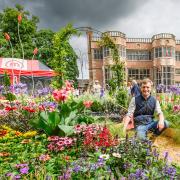The outline of White Coppice hill is framed by deep blue sky as one of the last matches of the cricket season plays out on the pitch below.
A tangle of Himalayan balsam and briars with beyond-their-best blackberries flanks the path from the whitewashed cottages fringing the pitch as the route leads north towards Wheelton Plantation.
The view of contrasting landscapes is striking. The wooded riverbank we have yet to reach is an abrupt dividing line between two worlds, the green grassed fields where cows and sheep graze, and the moorland where early autumn has turned heather to a soft mauve and bracken to rusty brown.
The afternoon has become languid but there is activity on this side of the moors – the buzz of a light plane overhead, dogs barking, a distant cock crow and the whinnying of unsettled horses in a paddock beside the path towards the wood half a mile off to the right.

A bird of prey lands on a phone wire over the open fields ahead. It’s clearly a kestrel, maybe a juvenile, and something in the long grass below has caught its interest. The kestrel takes to the air, briefly hovers for a second before settling back a few yards further down the wire and repeats the cycle, ending up a bit further still down the cable.
Looking towards the bird, there’s a sudden sense of the slope of the land away to the west. It feels like you could – if you were inclined (maybe declined) – roll very slowly all the way to the Irish Sea with nothing to stand in your way.
Back on the zig zag of paths heading for the plantation, clumps of haws have given the south-facing hedgerows a red hue along the side of the fields. The holly on the stony track towards The Goit and plantation edge is slower to bear fruit and its clusters of berries are smaller and only just starting to ripen.
Besides The Goit, birch leaves and sprigs of oak have fallen to decorate the ground. The whole of White Coppice is shaped by its past as a centre of mining and then milling but, like the thick moss covering the parapets of a narrow concrete foot bridge over the stream, nature has rounded the sharp edges of its industrial years.
Today the wood feels still, just the drift of an occasional birch leaf slowly falling through patches of light, and the steady southerly flow of the river down towards Anglezarke Reservoir.

There is micro-movement though: pondskaters darting over stream, a water boatman latching on to an overhanging blade of grass as it tries to hold its position against the contrary current, and insects crawling over a large but well nibbled fly agaric jutting out over the river bank.
It is quiet too. Just the rhythmic coo of woodpigeons, the distant chatter of small birds and the occasional crack as a falling nut hits the hardened earth.
We’re reluctant to swap the shady wood for the open ground of White Coppice hill so follow the stream back towards the cricket pitch rather than crossing the stream and heading up the bracken covered slopes.
Above the river path a mature oak tree stands proud, backlit by early autumn sun and crowned by wispy cirrus clouds in a field of thistle down and the ubiquitous Himalayan balsam. Brown and white speckled wood butterflies flutter alongside the riverbank.
Heading back down stream, the shrill claps and cheers from the White Coppice cricket match slowly creep back into earshot. The last over has almost been bowled, the hills will soon stop ringing to the crack of bat on ball and one of the most strikingly sited cricket pitches in Britain will be left empty until the green shoots of spring are making their presence known.



























